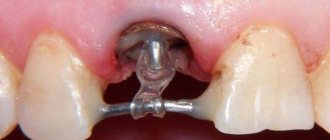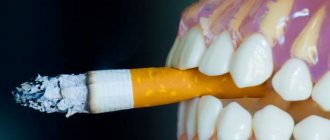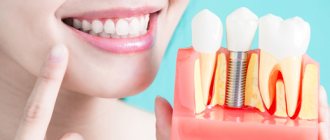Causes of the pathological condition
There are many reasons that lead to a swelling of the cheek from a tooth. Among them are:
- Toothache. A tooth hurts due to caries or pulpitis. Swelling may also occur after the element is removed. With proper treatment, the symptom goes away on its own within 2-3 days.
- Inflammation of the salivary glands and ducts. The cheek swells due to improper oral care or infection with viral and infectious pathogens.
- Sinusitis is inflammation of the sinuses. Swelling spreads to other areas of the face - eyes and cheeks.
- Damage to the lymphatic system. This factor is the most common cause of cheek swelling without tooth pain.
- Neuritis of the facial nerves. Pathology develops due to hypothermia of the body. Additionally, the problem is accompanied by impaired facial expressions and pain when talking and eating.
- Mumps is a viral disease that leads to damage to the salivary glands. One of the symptoms of mumps is swelling of the submandibular lymph nodes and cheeks. Swelling can manifest itself both unilaterally and bilaterally.
- Infectious mononucleosis. In terms of symptoms, the disease is similar to a sore throat and occurs in an acute form.
- Diphtheria. Occurs due to damage to the body by the Loeffler bacterium. Diphtheria is accompanied by the appearance of white plaque on the tonsils and fever. Antibiotic therapy does not give a positive result in treatment.
- Traumatic injuries to the soft tissues of the cheek. The healing period after injuries takes 2 to 3 weeks.
- Allergic reactions. There are situations when the cheek is swollen due to individual intolerance to food or oral hygiene products. You can get rid of the problem only by eliminating the provoking factor.
Swelling after surgery - normal or pathological?
Sinus lifting and other types of bone grafting are considered low-traumatic procedures performed by an experienced doctor. But in any case, this is not only a therapeutic procedure, but also a kind of trauma. As with any other surgical procedure, tissue damage is inevitable. After surgery, swelling develops, which is a physiological reaction of the body's defense systems.
Osteoplastic surgeries vary in complexity and extent of damage to the soft and bone tissues of the oral cavity:
- With an open sinus lift, incisions are made in the gums on the front side of the upper jaw to create access to the maxillary sinus, requiring sutures at the final stage of surgery.
- Closed sinus lifting is also accompanied by a violation of tissue integrity, since access to the bottom of the maxillary sinus is made by creating a hole in the gum and bone at the site of implant installation.
- Implantation of an implant during simultaneous implantation and sinus lift operations also provokes swelling as a protective reaction to a new object for the body.
- Other methods of bone grafting are carried out in various ways, but in any case they cannot be done without soft tissue incisions. Some outdated methods involve transplanting an autograft from one point of the jaw to the required area; we do not use such methods.
The severity of edema depends on the extent of the operation performed and the individual characteristics of the body . For example, women are more prone to puffiness than men. Typically, swelling is not a complication; during the normal course of the rehabilitation period it gradually decreases.
Our work is aimed at minimizing complications
We took the necessary measures at every stage - from preliminary preparation and implementation of low-traumatic protocols to a complex of proprietary rehabilitation.
Levin Dmitry Valerievich
Founder and Chief Doctor of the Center
Tumor due to improper treatment
Why else can pathology be observed? Separately, it should be noted the swelling of the cheek, which arose as a result of illiterate therapy. If the cheek is swollen after a complex tooth extraction, then this is a variant of the norm. The symptom disappears on its own after a few days. Typically, such swelling is small in size and does not cause pain to the patient. The situation does not require repeated surgery.
The opposite situation arises if we are talking about an infectious process that has begun after medical care has been provided. Complications are more often observed after the removal of wisdom teeth or a retained element. Such operations cannot be performed without significant damage to soft tissue. Complications arise due to doctor errors or when the patient fails to comply with the dentist’s recommendations during the recovery period.
The impacted tooth is located in the deep tissues of the gums due to incomplete eruption or incorrect location
The gums also swell due to improper sanitation of the diseased tooth. In this case, repeated assistance from a specialist is required, followed by taking medications and local treatment of the affected area. After complex removal of an element, swelling can be observed for up to 2 weeks.
Swelling also often develops due to allergic reactions to painkillers used by the dentist during treatment. In this case, additional symptoms are observed (heavy breathing with whistling, shortness of breath), but the tooth does not hurt. A person requires urgent hospitalization to cleanse the body of the allergen.
Symptoms that require urgent help
You should not postpone a visit to the doctor if your cheek is swollen from a tooth. The condition can be fatal.
The list of dangerous signs includes:
Headache after tooth extraction
- Unbearable toothaches that appear constantly. The condition indicates that an infection has attached to the surgical field. Severe pain is acceptable only after operations involving cutting out part of the bone tissue. Pain sensations decrease after 1-2 days, otherwise urgently contact the dentist.
- Temperature rises to 38 degrees and weakness.
- Pain when opening the mouth, swallowing and eating food.
- A compaction revealed by palpation of the problem area.
- Absence of a blood clot in the socket. A clot does not form due to intensive mouth rinsing on the first day after surgery or other illiterate actions of the patient that provoked a violation of soft tissue regeneration. The condition threatens the occurrence of acute symptoms and infection of the maxillofacial tissue.
Also, immediate consultation with a doctor is required in cases where the tumor is rapidly growing in size.
Due to the lack of blood clot formation, infectious complications develop after a tooth has been removed (pulled out).
When swelling is a sign of complications
Despite the fact that the appearance of edema and other symptoms is a physiological phenomenon due to tissue damage, they should not cause unbearable discomfort to the patient. If the symptoms are pronounced and significantly worsen the quality of life in the postoperative period, you need to talk about complications and immediately consult your doctor.
Alarming signs in which you should think about the development of a complication or an abnormal reaction that requires immediate correction:
- High rate of development, rapid increase in size of edema, transition of edema to the soft tissues of the face.
- The swelling is dense, the consistency of an eraser.
- Lack of positive dynamics - does not begin to decrease from the 3rd day after the operation.
- Impaired speech and chewing function due to edema.
Associated factors also indicate the occurrence of a problem.:
- An increase in body temperature above 38 degrees for longer than a day.
- Severe pain at intervals of less than three hours (even when taking painkillers).
- Discharge of a large amount of ichor, bleeding from the wound.
- The addition of a bacterial infection, manifested in suppuration in the wound area.
- Strange odors from the post-operative area.
If one or more of the above symptoms appear, you should immediately contact the dentist who performed the sinus lift or bone grafting. Find him and explain the situation, don’t delay. It is dangerous to self-medicate in such a situation , so entrust the treatment of the emerging complication to an experienced specialist.
If you are undergoing treatment at our Center, immediately contact the 24-hour support service by calling from your card.
First aid measures
What can you do at home to reduce the intensity of the symptoms? If the gums are swollen, but the condition is not accompanied by a general deterioration in the condition: a rise in temperature and signs of intoxication, then first aid measures can be carried out.
How to remove a tumor? First aid includes the use of various herbal remedies to rinse the mouth. For this purpose, chamomile, St. John's wort, and oak root are used. Herbs will relieve inflammation and stop the proliferation of pathogenic flora in the mouth. The procedure is performed every 2 hours for 1-2 minutes.
Instead of herbal decoctions, antiseptic drugs are used - Stomatodin, Chlorophyllipt. The drugs are diluted with warm water and rinsed with them every 3-4 hours.
Chlorophyllipt is used in dentistry for exacerbation of infectious diseases
What should not be done if the gum area is swollen? If a tumor occurs, they refuse to heat the problem area. This leads to a worsening of the situation and further spread of the pathological process.
If your tooth hurts badly and your cheek is swollen, take anti-inflammatory drugs - Nise, Nurofen, etc. Analgesics – Solpadeine and Ketanol – can help relieve swelling well. The latter remedy has many side effects, but can cope with any type of pain. If a child’s cheek is swollen, then preference is given to anti-inflammatory drugs in the form of syrup.
Treatment of pathology
What to do if there is a problem? After providing emergency assistance, the patient should consult a doctor. The specialist performs the necessary manipulations and then gives the patient recommendations regarding caring for the damaged area at home. These include mouth rinsing, physiotherapeutic procedures and local treatment of the soft tissues of the mouth. Providing emergency assistance for a cheek tumor is prohibited for children; women during pregnancy; adults who suffer from immunodeficiency; persons prone to allergic reactions.
General antibacterial drugs
Ideally, a suitable medication is prescribed after taking a swab from the mouth and identifying the causative agent of the problem. But if the situation is urgent, then to quickly eliminate the flux, the patient is prescribed new generation antibiotics. The action of the tablets is aimed at destroying and slowing down the spread of bacteria. For pathology use: Biseptol, Ampiox, Amoxiclav, Lincomycin.
Ointments
In addition to antibiotic therapy, topical medications are used. The use of products is permissible only with the permission of the dentist, since self-prescription of ointments rarely leads to recovery.
To reduce the intensity of the inflammatory process, Levomekol containing metaluracil and chloramphenicol is prescribed. Levomekol is rubbed into damaged membranes of the oral cavity 3-4 times a day. After treatment, you should not eat or drink water for 1 hour.
List of ointments that are used if a child’s cheek is swollen
To quickly get rid of the symptoms of swelling, you can use antimicrobial ointments in combination, for example, Streptomycin and Ichthyol. The drugs are mixed in equal proportions and applied to the damaged gum. Another popular drug of combined action is Metrogyl Denta.
Means for rinsing procedures
How to rinse the problem area? To quickly get rid of the remaining pus after surgery, and to prevent the development of swelling of the cheeks, use folk and household rinses. Several recipes are suitable for this purpose:
- Soda solution: 1 tsp. the main ingredient is dissolved in 100 warm water. Mouth baths are done at least 4 times a day.
- Miramistin. The drug is sold ready-made and does not require prior dilution. To treat foci of infection, take 20 ml of liquid into the mouth and rinse the mouth for 1 minute. After this, the liquid is spat out.
- Propolis solution. The drug is purchased at the pharmacy and diluted with boiled water in a ratio of 1:10. The product is used after meals.
- A mixture of St. John's wort, oak bark and sage: take 1 tsp. each ingredient and pour 500 ml of boiling water. The product is infused in a tightly closed container for 6 minutes. After filtering, the solution is used 3 times a day to relieve gum inflammation.
- A blend of green tea and sage. The dry collection is brewed with 500 ml of boiling water with the addition of 1 tsp. salt. The solution is recommended to be used warm. Before each procedure, it is advisable to prepare a fresh product.
- A mixture of chamomile, birch buds and calendula: the components are mixed in equal proportions and diluted with 1 liter of water. The mixture is boiled for 10 minutes, and then left to cool completely.
It is important to refuse the procedure in the first 24 hours after the intervention so as not to wash out the clot.
How to remove at home
The instructions for the postoperative period indicate in as much detail as possible what will help reduce the size of the swelling. Please read it carefully.
Cooling compress
The bag of post-op medications contains ice in a blue bag, freeze it in the freezer and reuse. Immediately after bone grafting, it is recommended to apply an ice pack (previously wrapped in a cloth or towel) to the cheek on the side of the operation. The duration of such a compress should not exceed 10-15 minutes, after which you need to take a half-hour break. The effect of using this simple method appears almost instantly - pain subsides, swelling stops increasing.
It should be taken into account that there are contraindications to this method of eliminating swelling, for example, trigeminal neuritis. Cold compresses are recommended for the first 24-48 hours, since it is during this time period that their effectiveness and safety are highest. If you hold the ice for longer than 15 minutes, there is a risk of hypothermia, be careful with this!
Taking medications
In addition to the local effects of low temperature, do not forget about taking medications. After osteoplasty, patients are prescribed anti-inflammatory and painkillers that help reduce or eliminate swelling and cope with other unpleasant symptoms of inflammation. In addition to anti-inflammatory drugs, multivitamins and broad-spectrum antibiotics are prescribed to prevent bacterial complications. You should take medications strictly as prescribed by your doctor or as instructed, without exceeding the permissible dose.
Diet
Also during the rehabilitation period, the prevention of edema is following a proper diet, drinking regimen, complete exclusion of chewing load on the side of the operation, regular brushing of teeth and baths with an antiseptic after each meal.
Read more about the rules of the rehabilitation period here - After a sinus lift
All these measures are aimed at relieving the symptoms of inflammation and thereby reducing swelling after sinus lifting and bone grafting. Eating spicy, too hot, hard food irritates the mucous membrane of the gums and increases swelling, and failure to maintain oral hygiene and neglect to use an antiseptic increases the risk of infectious complications.
Our doctor will inform you in detail about all the nuances of the postoperative period so that tissue restoration after surgery occurs quickly and does not cause discomfort.
Prevention
The main procedure for preventing cheek swelling is timely treatment of caries and other dental problems.
Simple recommendations will also help maintain oral health:
- Regular dental care. Dentists advise using more than just a brush and paste. To effectively clean your mouth from plaque, you can use dental floss, floss and irrigators. You should also not forget about cleaning your tongue, since most of the bacterial flora is concentrated there.
- Pay attention to the condition of your gums. If these structures are loose and bleeding, they turn to a specialist - a periodontist.
- Visit your dentist at least once every 6 months for a diagnostic examination and professional teeth cleaning.
- Change your eating habits. Carbonated drinks, sweets and alcohol have a detrimental effect on the condition of teeth and enamel. To maintain dental health, it is better to consume fermented milk products, fresh vegetables and fruits.
Swelling of the cheek should not be ignored; in addition to aesthetic problems, the condition can threaten human health. More often, the problem develops against the background of developing caries and improperly performed dental work. If the inflammation is not accompanied by bleeding, fever and other dangerous signs, then emergency measures are taken at home, and then see a dentist. Preventive methods regarding cheek swelling are simple and accessible to every person. Their implementation will minimize the frequency of visits to the dentist.











